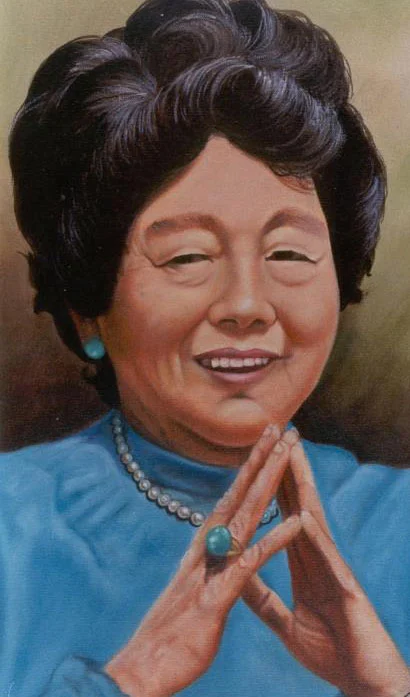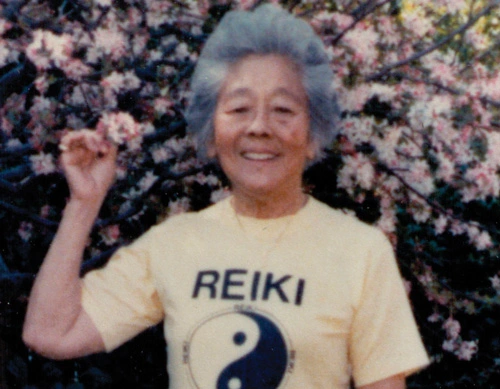History of Reiki - Hawaio Takata
Reiki is available to anyone who seeks it
Hawayo Kawamuru nasceu na Ilha das Flores de Kawai, localizada no Havaí – arquipélago que foi anexado aos Estados Unidos em 1898. Seus pais, o casal Kawamuru, eram imigrantes japoneses que batizaram a filha com o nome da ilha, acrescentando um “o” até a última letra de acordo com a tradição de nomenclatura para meninas. Ao contrário de seus pais que eram trabalhadores agrícolas, Hawayo não era fisicamente forte, sendo magra, com menos de 1,50m de altura, mãos delicadas e olhos brilhantes e alegres.
Em suas orações, Hawayo pedia a Deus que a guiasse para um tipo diferente de trabalho manual que não estivesse relacionado à agricultura. Trabalhou como colheitadeira de bambu e cana-de-açúcar e, mais tarde, durante as férias escolares por volta de 1914, lecionou para alunos da 1ª série em uma escola religiosa. Hawayo também trabalhou em um balcão de bebidas em Lihue e, posteriormente, em um casarão colonial de uma senhora elegante, onde passou vinte anos como governanta e supervisionava o trabalho dos 20 funcionários da mansão.

On March 10, 1917, Hawayo Kawamuru married Saichi Takata, a young accountant who worked in the same residence. Together they had two daughters. However, in 1930, at the age of 34, her husband died of lung cancer. The overwork, necessary to support his family, as well as depression and serious psychological problems, severely affected his health. At the age of 35, Hawayo developed lung problems and an abdominal tumor.
During the absence of his parents who, after 40 years, returned to Yamaguchi, Japan, to spend a year’s vacation, one of Takata’s sisters, newlywed and only 25 years old, died of tetanus. Hawayo was sensitive to the fact that the news was too sad to be given to her parents by mail. So Takata decided to communicate the news personally, taking the opportunity to care for her health at the Maeda Clinic in Akasaka, where her husband had been treated before his death.
In 1935, upon returning to Japan after a ten day, overnight boat trip, it was discovered that Takata had an abdominal tumor, as well as gallstones and an appendix problem that caused constant stomach pain and prevented him from walking upright. Takata was admitted for surgery. Minutes before the operation, in the operating room, Hawayo heard a voice several times stating, “the operation is not necessary.”

He felt at that moment that there was another way to cure her. The doctor, upon being informed of the “warning,” canceled the operation and referred her for Reiki treatment at Dr. Hayashi’s Shina no Machi clinic. There she began receiving daily treatment and within four months was completely healed. She had gained 10 kilos and looked 10 years younger. During the treatment, Takata did not understand how the hands of the people treating her got so hot and even looked for hidden batteries in the Reiki practitioners.
Hawayo felt the desire to learn Reiki, but this practice was reserved for men in Japanese society and inaccessible to foreigners. After being denied her first attempt, she argued that she wanted to help Japanese American immigrants, and so she was allowed to learn Reiki, on the condition that she remain in Japan and work at the Reiki clinic every day for a year. Takata stayed with Dr. Hayashi’s family and received her first level of Reiki in the spring of 1936. She successfully treated many different cases and learned that to treat the effect, it was necessary to remove the cause.
Having met the requirements imposed for the first level, Takata received the third level and paid five hundred dollars. She then took to Hawaii, with no intention of becoming a Reiki practitioner. In October 1936, she settled with her family in a house in Hilo on Kilauea Avenue, where she operated her first stay for 10 years. Hawayo was visited by Dr. Hayashi and his daughter, who spent six months in Hawaii giving lectures and learning about Reiki.
In February 1938, before Hayashi left Hawaii for Japan, he told his students that Takata, from that moment on, was a Reiki Master and was authorized to transmit the technique. She was the seventh female teacher of the XX in the world, and the first woman in the West, remaining the only one until the year 1970. We can say that Dr. Hayashi was a mystical century: he felt that war between Japan and the US was imminent, and as a navy reservist, he could not reconcile being a Reiki Master and having to serve in the army again.

In 1940 Takata had a dream about her master Hayashi dressed in a white silk kimono. This made her uneasy, leading her to travel to Japan to see him. Upon her arrival, Hayashi informed her about the war and advised her on what to do to avoid the dangers of being a Japanese American citizen living in Hawaii. All his predictions came true and this helped to protect the spread of Reiki. After all the necessary steps were taken to preserve Reiki, Dr. Hayashi passed away on May 11, 1940, in Tokyo. Takata was devastated by the loss of her beloved master, but continued to practice and teach Reiki, spreading its benefits to others.
During World War II, Takata faced many challenges due to her Japanese heritage and discrimination against Japanese Americans. She had to move her Reiki practice from Hilo to Honolulu, where she faced more scrutiny and suspicion from the authorities. Despite these obstacles, she continued to teach Reiki and even gave treatments to soldiers and prisoners of war. After the war, Takata focused on expanding Reiki to the West, traveling extensively to teach and give demonstrations. She eventually trained 22 Reiki Masters, including her granddaughter, Phyllis Furumoto, who later became the carrier of the Usui System of Reiki lineage. Hawayo Takata passed away on December 11, 1980, leaving a legacy of healing and spreading the practice of Reiki to the world. Today, Reiki is widely recognized as a holistic healing technique and is practiced by millions of people around the world.